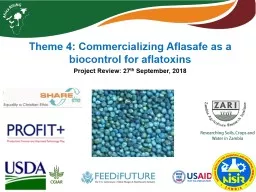

Aflasafe as a biocontrol for aflatoxins Project Review 27 th September 2018 40 of Zambian children not getting the best start in life Very low weight for height amp severe muscle wasting ID: 790012
Download The PPT/PDF document "Theme 4: Commercializing" is the property of its rightful owner. Permission is granted to download and print the materials on this web site for personal, non-commercial use only, and to display it on your personal computer provided you do not modify the materials and that you retain all copyright notices contained in the materials. By downloading content from our website, you accept the terms of this agreement.
Slide1
Theme 4: Commercializing Aflasafe as a biocontrol for aflatoxinsProject Review: 27th September, 2018
Slide240% of Zambian children not getting the best start in life!(Very low weight for height & severe muscle wasting)
Facts form ZDHS 2014)9% born underweight (<2.5 kg)60% are anemic
Stunting rate: 40%Micronutrient deficiencies very common
Nutritional status of babies aged 6-24 months
Slide3Complementary food type
Food type
Proportion (%) of children fed
Chibwantu
drink
3.2
Groundnut relish
1.8
Nshima
66.4
Porridge
21.5
Samp7.1
Various types of foods administered to children on case by case basis, from 0 month.
Main challenge: maize-based foods with minimal dietary diversification
Slide4Nutritional composition of complementary foods
Parameter
Mean (g/100g) for
Chipata
district (
N=60)
Mean (g/100g) for
Monz
e district (
N=41)
Moisture content
78.8±4.
8a82.5±1.5aDry matter21.2±4.8a17.5±1.5aAsh0.4±0.3a0.2±0.1b
F
at
0.2±0.1a0.3±0.2aProtein2±0.8a2.2±0.1aSugar1±0.6a0.1±0.1bStarch21.5±4.0a16±0.3bTotal carbohydrate18.7±4.7a14.8±1.3b
Traditional complementary foods low in fat & protein contents
Recommended daily intake: Protein: 0.8g/
kgbw
; Fat is 44-78g
Slide5Complementary food quality
Complementary food quality compromised by presence of aflatoxin
Food type
Max
Mean
Proportion of complementary food (%)
<4ppb
5-10ppb
11-20ppb
>20ppb
Unsafe for babies, >2ppb
Chibwantu
7.02.190.99.10.00.018.2Gnut relish98.02150.016.716.716.750.0Nshima34.0392.02.72.72.718.2Porridge104.05.393.10.04.24.2
27.8
Samp
500.030.683.38.30.04.225.0Aflatoxin has negative impact on health-may retard growth
Slide6Main activities
Aflatoxin surveillance: microbial & chemical analyses
Capacity building
Awareness creation
Aflasafe Product developmentAflasafe
efficacy & registration for commercial use
Improving food safety, public health & income through aflatoxin mitigation
FTF INITIATIVE: 2011-2015
Slide7Limited data on
aflasafe
efficacy
Aflasafe upscaling & commercialization: focus should cover the entire country, thus necessitating evidence on efficacy in other regions
Un-registered productLack of awareness
Lack of legal framework for pesticide registration
FTF initiative: gaps as of 2015
Slide8Assessing
Aflasafe
efficacy in Region I & III AEZ
Creating awareness Pursue full registration of
aflasafe for commercializationDevelop a business plan
Africa RISING: Going to Scale in EP of Zambia
Slide9Approaches of taking the technologies to scale
Private sector engagement for on-farm
field trials
Extension systems (Ministry of agriculture) and community
agro
-dealers
Stakeholder consultative meetings: e.g. AATF workshop
Slide106 tons of
aflasafe
imported from Nigeria/ Tanzania
150 maize fields335 groundnut farms
Aflasafe
: evidence of efficacy
Slide11< 4
< 10
< 20
> 20
EU
COMESA
USA
UNSAFE
Maximum allowable aflatoxin level (ppb
)
Aflasafe
: evidence of efficacy
Slide1299% G 80% M 99% GN 97% M 95% GN 75% M
Aflasafe
: evidence of efficacy
Slide13Market & demand
Market: Local processors, school feeding programs, regional traders, consumers
60% of farmers willing to pay for such a product
Potential aflasafe manufacture: Share-Africa Zambia & ZAMSEED
Companies expressed need for seed money to jump start the manufacturing processPotential distribution channels
Seed & input supplies
NGOs & development partners
Business Plan development: Feasibility assessment
Slide144. Awareness raising
Year
Female
Male
2015/2016
205
162
2016/2017
171
161
Slide15Technology Transfer Agreement prepared & Signed
2 Dossiers submitted to ZEMA
Feedback provided
ZEMA Engagement
2015
Registration requirements identified
Review & Independent evaluation
ZEMA approval
Dossier
Re-submission-July 2018
Aflasafe
product registration journey
APPROVEDAugust 2018
Slide16Market & demand
Market: Local processors, Govt school feeding programs, regional traders, consumers
60% of farmers willing to pay for such a product
Potential aflasafe manufacture: Share-Africa Zambia & ZAMSEED
Companies expressed need for seed money to jump start the manufacturing processPotential distribution channels:
Current distributer- ZARI Seed & input supplies
NGOs & development partners
Business Plan development: Feasibility assessment
Slide17Exposure to aflatoxin is occurring but awareness is low
Solutions are available
Way forward
Effective communication strategy to increase awareness
Pursue full registration of Aflasafe
Develop aflasafe commercialization strategyPublic/ private sector driven for faster uptake and diffusion of the technology
Engage
aflasafe
interested stakeholders for limited use of the product
Sourcing funds for implementing a commercialization strategy
Aflasafe
importation: need for import license
Construction of manufacturing plant: legal requirement-an EIA Conclusion & Way forward
Slide18Aflasafe team